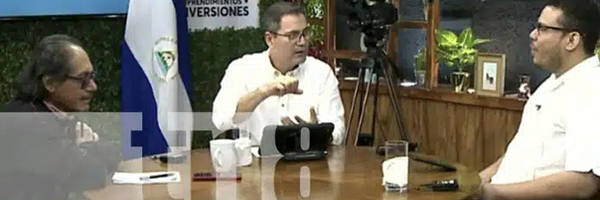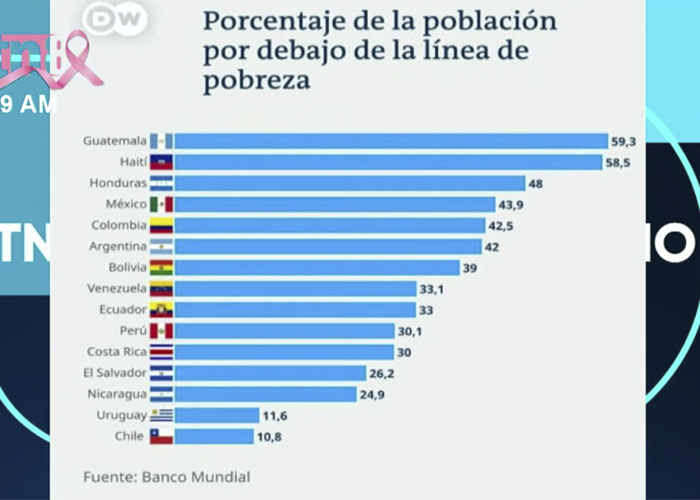Nicaragua Stands Out in Latin America With Its Lower Poverty Rate
 Ontinoco Tribune, January 24, 2023 — On today’s broadcast of Estudio TN8, we talk about how Nicaragua stands out in Latin America in terms of its poverty reduction with economist Frank Matus and sociologist and political analyst Freddy Franco.
Ontinoco Tribune, January 24, 2023 — On today’s broadcast of Estudio TN8, we talk about how Nicaragua stands out in Latin America in terms of its poverty reduction with economist Frank Matus and sociologist and political analyst Freddy Franco.
Frank Matus: Within Latin America, Nicaragua is among the countries that has best managed to reduce its poverty rate. In 2007, Nicaragua’s poverty rate was at 48.3%. After the transition to a Sandinista government, this percentage has been steadily reduced and currently is at 24.9%.
Estudio TN8: How was this possible?
Freddy Franco: I think the key was the arrival of the FSLN government, which proposed a national strategy to fight against poverty and for human development and to overcome the whole neo-liberal model which had left us a country practically in bankruptcy. Since 2007, the country has been moving forward because there is a national development strategy that includes economic development with social rights, and economic growth with equitable distribution of wealth. This means that a series of rights that were violated during the neo-liberal period have been restored: free health care, free education, access to housing. More than 125,000 families, for example, have had their housing problems solved during these last ten years. More than half a million property titles have been given out.
The government has sought mechanisms to finance micro, small, and medium-scale producers in the countryside and the city, as well as to empower women. It has created a whole strategy of economic development with social growth as well. So, that is what explains, I think, why we are placed [where we are]. Before, it was said that Nicaragua was the second poorest country in Latin America.
There are countries like Guatemala with 59% living in poverty, Argentina with 42%, and Costa Rica with 30% while we are at 24.9%. That means that Nicaragua, of those 15 countries which are located in this range of poverty in Latin America and the Caribbean, Nicaragua is the second to last least poor country.
There are different ways to measure poverty. One of them is by income as a country divided by the number of inhabitants. Then you say this is the per capita income. But we are beyond per capita income. There are a series of social rights and social programs which impact the material and spiritual well-being of Nicaraguan families. Income to workers is improved; social security grows twice as much; there are a series of subsidies for energy, water, transportation, and other things.

Frank Matus: The turning point in the fight against poverty in Nicaragua was when the FSLN took over the government in 2007. The key element is the political element. The fight against poverty has an important component which is political will; without political will, there is no fight against poverty. For the previous governments, the reason why they reduced poverty at lower rates or did not reduce it at all was because it was not their objective; it was not the priority of their policies. This is also reflected in other countries of Latin America, where the oligarchy governs and for them poverty is acceptable.
In their discourse, everyone is against poverty, but the agenda of the oligarchy benefits from poverty. The FSLN has a different character, a revolutionary character; it has a social character and that is why it makes poverty reduction a priority for the policy agenda.
Compañera Rosario Murillo said year before last that “Poverty is the enemy to defeat,” and based on that a whole regulatory superstructure has been created, starting with the National Plan for the fight against poverty and for human development 2022-2026. From this a series of strategies, programs and projects that have to do with the fight against poverty are derived. The common denominator of all actions is the fight against poverty.
Freddy Franco: In Nicaragua and in Latin America over the last 35 years the neo-liberal model was put in place, a privatizing model, a model that affected social rights. National economies were damaged by transnationalization [the selling of state property at fire-sale prices to foreign corporations] and by the elimination of mechanisms for the distribution of wealth.
You see countries like Argentina and Mexico, which have a very high poverty rate but an important issue that is not often raised in Latin America is whether people have access to welfare in terms of social policies, in terms of culture and education, social programs, and real economic opportunities. Nicaragua has been building a path of wealth distribution with a national strategy which establishes strategic goals every five years which means that Nicaragua is no longer the second poorest country in Latin America.
Another important element, besides social policies, is the government’s concern in investing in productive infrastructure such as bridges. Nicaragua has development strategies and economic opportunities for the population, for the micro, small, and medium scale producers in the countryside and the cities.
There are three aspects to highlight on the World Bank graph. First, I want to clarify that the World Bank, ECLAC [UN Economic Commission on Latin America and the Caribbean] and others use data from INDE [Nicaraguan Development Institute]. That is, just as the results of the fight against poverty are ours, so are the data. We collect it through the poverty survey, the survey of living standards, the poverty map, and others.
There are different ways of measuring poverty. There is the baseline, which is the methodology incorporated in the chart. What it explains is how people are classified between poor and non-poor based on whether people have an income that allows them to satisfy a set of needs of consumption; that is to say, whether they can purchase sufficient goods to have a decent life.
We must understand that poverty is a broad-spectrum phenomenon. Poverty is a multidimensional phenomenon with historical causes. So, the approach to poverty must be comprehensive, because we can have someone who has a high income but lives in a neighborhood where there is no drinking water or sanitation, where there are no street lights or public safety, where there are no paved streets.
With the current economic recovery process, we have macro-economic stability and that allows us to have the resources to support the fight against poverty. Nicaragua has many achievements in relation to the United Nations Sustainable Development Goals. I believe that Nicaragua has advanced a lot in a series of challenges that humanity is facing with its reduction in poverty, access to drinking water, education, and health care. We have an economic growth projection which is double the projected growth rate for Latin America as a whole.
There is an effort by the country to subsidize fuel and cooking gas and other things. This has an impact on the economy and benefits the family. The family is not spending that money. If you were, you would be able to buy less with your income. Inflation would skyrocket. We are working to control inflation which is a risk in all countries. Nicaragua has subsidy policies that protect the population and an economic strategy that is bringing back the economy.
In terms of the pandemic, Nicaragua recovered quickly while the rest of the world is still struggling with its effects. There is a whole series of factors in the world economy that raises the costs of transportation and goods. Although it impacts us, we have mechanisms to control it [such as covering the recent increases in the prices of petroleum products since March 2022].
